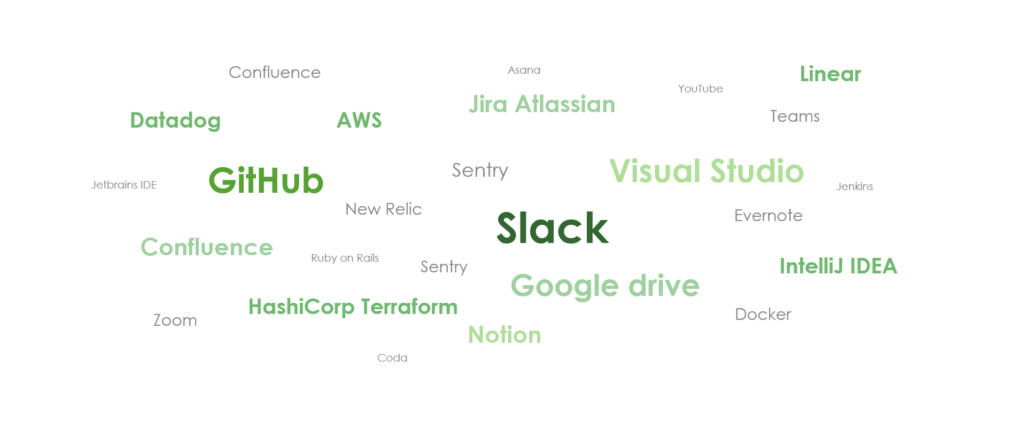


The last two years have been monumental in terms of the impact current events have had on modern business. But even before the impetus of COVID-19, there was already a more fundamental transformation taking place with the rise of product-led business models, one piece of which includes the rise of the developer-buyer. Jeff Lawson, Founder & CEO at Twilio, wrote a book called Ask Your Developer, playfully named after the billboard advertisement from 2015 that helped launch Twilio’s successful campaign to engage executive awareness, where he highlights the fact that every industry is turning digital, and every company needs the best software to win the hearts and minds of customers.
In the past, even though developers have been highly paid and desperately in-demand, many organizations have treated them like vocational workers without really understanding how to unleash their full potential. In truth, developers are the future creative workforce who will be able to solve business problems and create hit products for customers—not just grind through rote tasks. Companies that bring developers on as partners are winning, and part of that partnership includes ensuring that they have the right tooling and support to accomplish an increasingly sophisticated array of goals.
We partnered with the SF Engineering Leadership Community to survey a cohort of 125+ engineering leaders and see where their thoughts are today around priorities, tooling, and whitespaces.
To kick things off with this first inaugural developer survey, we wanted to get a feel for our participants.
About a quarter of respondents are VP-level or above, in charge of managing large teams, with another two-thirds at either manager or director-level. This is also a very tenured group, which makes sense based on the managerial focus, with over three-quarters of respondents reporting 10 years of experience or more.

In terms of education, self-education was in the minority at just under 10% (although still a sizable representation), with a fairly even split between graduate and undergraduate degrees otherwise. Finally, in terms of location, And in terms of location, about three-quarters of participants were based in the United States – with the majority on the west coast. The greater San Francisco Bay Area was the most common response to this question.

While DevOps as a function can certainly be described as a cultural shift as much as it is a tooling problem, the right stack can make it far easier to implement successful practices that enable seamless collaboration and automation across the dev and operations teams. While this is a somewhat broad category that can encompass topics ranging from bug tracking, to application release orchestration, to automation testing – a few clear leaders did emerge. GitHub and GitLab, which are both leaders in the first two categories, came in with close to 50% and 25% usage across respondents, respectively.
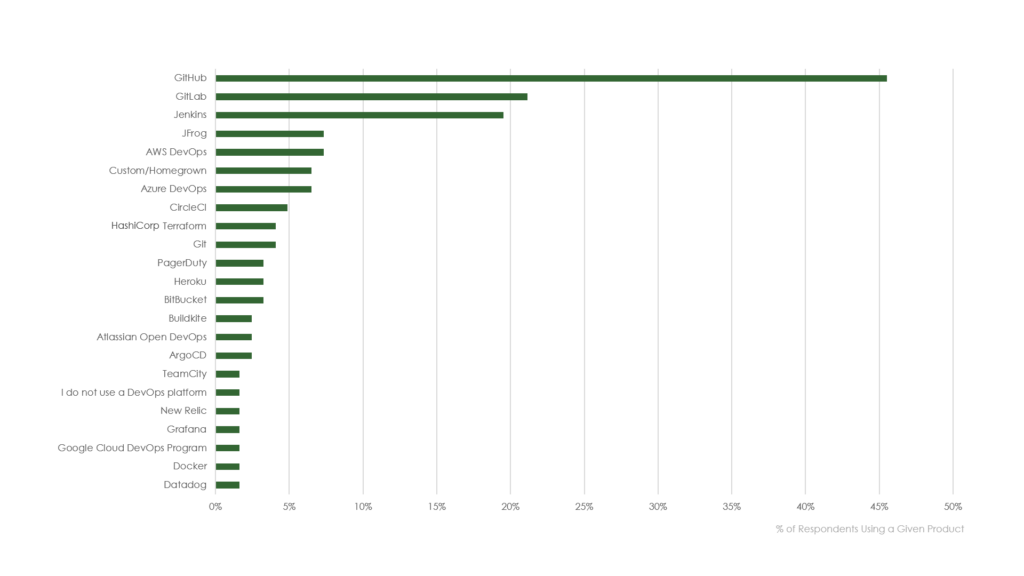
DevOps isn’t just about development and operations teams. If an engineering org wants to lean into the agility and responsiveness of a DevOps approach, IT security also has a role to play in the full life cycle of a company’s apps.
With that said, the responses to this question were a little surprising: Over a quarter of participants said that they do not use a DevSecOps platform today. This could be in part because it’s a nascent category, or because many development teams may still lack security and compliance expertise–one of the most common DevSecOps challenges (this is also a problem on the flipside–with security and operations teams lacking software experience alongside a general lack of talent in the space). Nonetheless, it would appear there is still work to be done here. Out of participants who are currently using a platform, Snyk was far and away the winner – with SonarQube a distant second place. There are also several nascent solutions in the space seeking to automate some of the trickier pieces around security and compliance – DuploCloud being one of them.
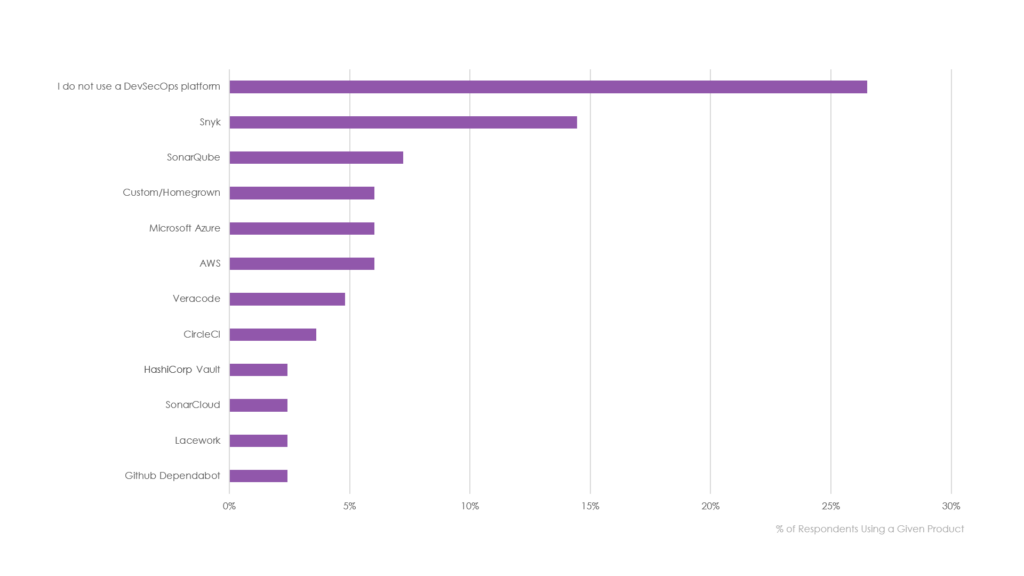
Modern infrastructure automation aims to limit human interference in managing components of IT infrastructure, and the tooling for it is designed to assist in various processes such as installation, configuration, and maintenance. This both enhances IT operational efficiency and mitigates some of the risk of human error.
Two obvious leaders emerged from our survey in the space: Datadog and HashiCorp Terraform, with each being used by a little over a third of our participants. Other competitors include AWS Cloud Development Kit, New Relic and Ansible.
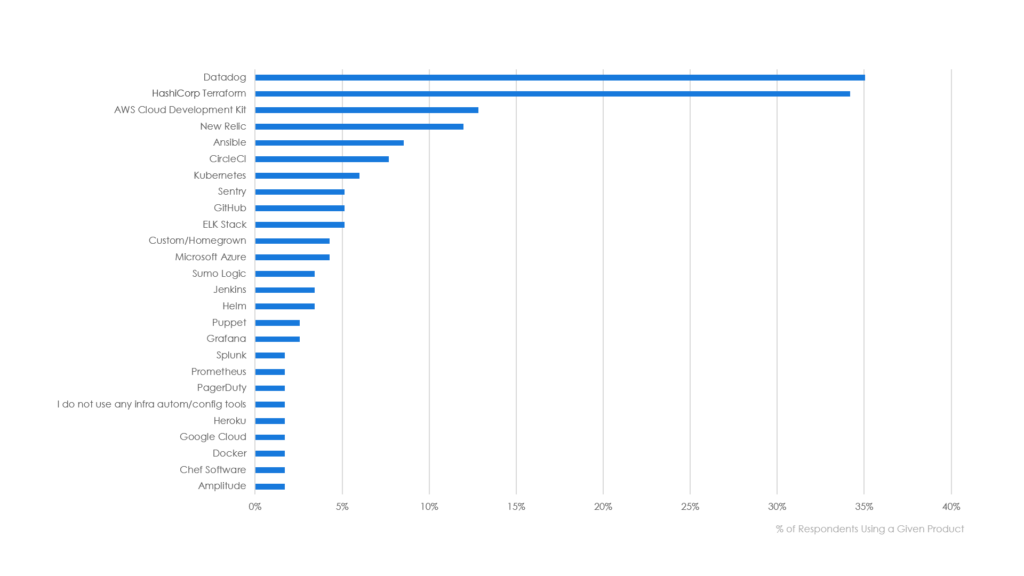
When building or designing complex microservice-based applications with multiple client apps, a good approach to consider can be an API Gateway, which provides a single-entry point for certain groups of microservices. Similar to the responses we got in the DevSecOps category, nearly a quarter of our respondents either don’t use one (14%) or have a custom/homegrown setup (10%).
For those that do, the clear leader is AWS API Gateway (with a huge lead), followed by Apigee API Management, Datadog, Kong, Terraform, Sentinel, and NGINX.
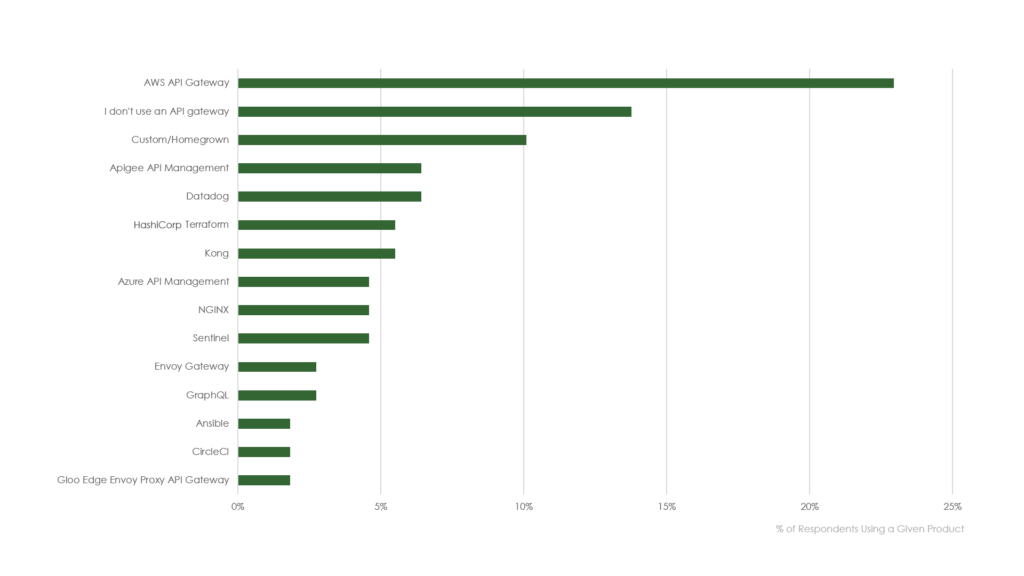
Modern architectures increasingly rely on service mesh to secure cloud-native applications (on account of the inherent moving parts in modern apps today). These application components can consist of thousands of varying instances, containers, and APIs. As a result, service mesh tools are often used in tandem with container management software, container orchestration software, container networking software, and service discovery software. That being said, a full one-third of respondents still don’t use service mesh today, which implies that there are definitive gaps with existing service offerings. Out of our participants who do use service mesh, HashiCorp Consul and Istio were the clear winners, with 15 and 20% of the field, respectively.
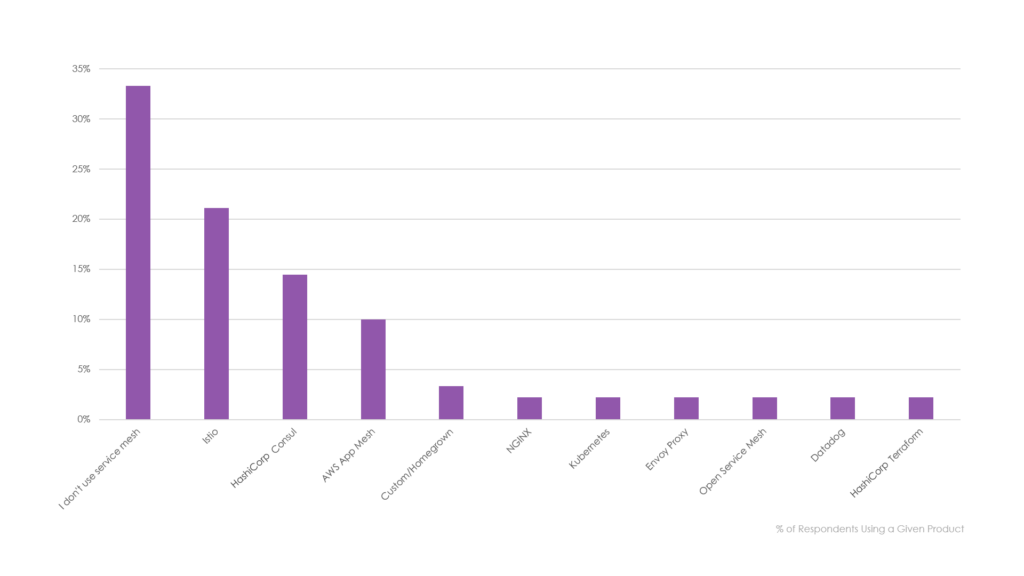
Customer identity management platforms enable organizations to add identity and access management functionality to their applications in order to protect their user accounts and scale more safely. They usually provide a combination of features including customer registration, self-service account management, preference management, single sign-on, multi-factor authentication, access management, directory services and data access governance – all with the ultimate goal of ensuring an appealing customer experience regardless of scale and performance, no matter which channels (web, mobile, etc.) customers use to engage with a brand.
This was a rather competitive category compared to some of the others, with several popular options (and nearly a quarter of participants using a homegrown solution). Auth0 was the leader here, closely followed by Okta, with many other contenders including Twilio Segment, Azure Active Directory, and Amazon Cognito.
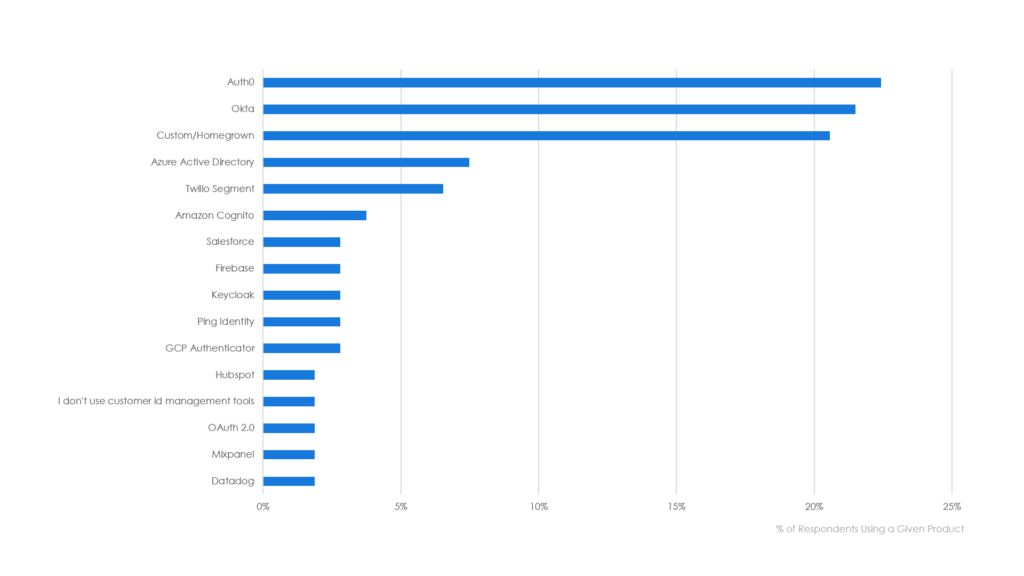
During software development, secrets are necessary for linking things securely. The verification of secrets is how servers know the source identity of the requests they get. Too often, the common (but not best) practice is to keep everything in clear text and hope for the best. This is terrible because it exposes a business’ applications to vulnerabilities through accidental code versioning commits. Moreover, it places code secrets, keys, credentials, APIs, and tokens in easily viewable locations.
Secret management tools were created to keep credentials and code secrets secure, organized, and accessible to the right people and machines. The two strong leaders here came out as Vault (part of HashiCorp’s product suite), and AWS Secrets Manager, with other popular tools being 1Password, Azure KeyVault or even just building something custom.
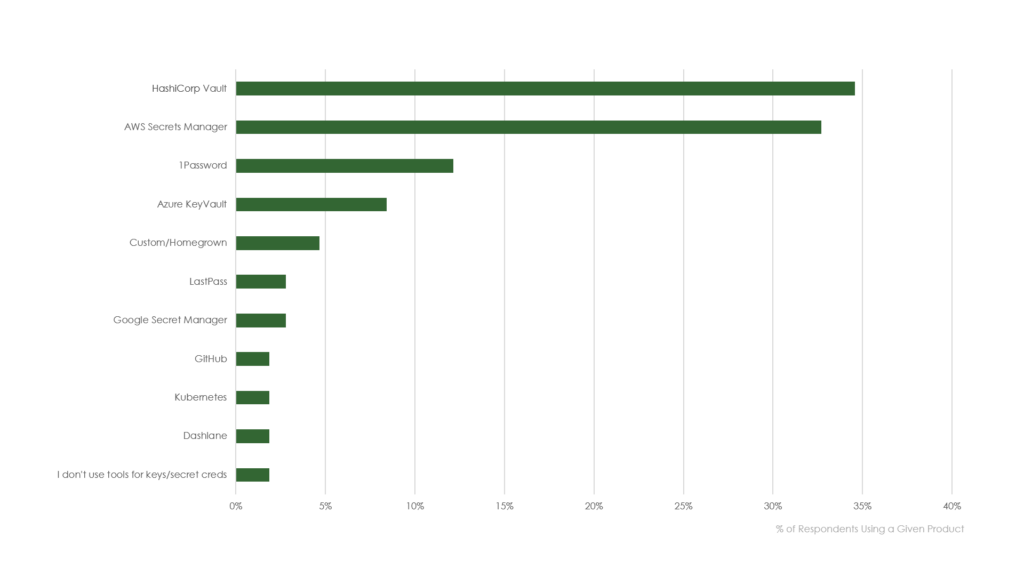
Maintaining high productivity as a developer can be challenging – coding requires a lot of concentration, and context switching in between meetings and heads down work time can be very disruptive. At its core, being productive means performing tasks efficiently, but while some aspects of developer productivity are workflow-based (avoiding procrastination, wasting time, being inefficient), being effective is important as well.
There are so many productivity apps available for developers today, and by using those apps, work quality and productivity can greatly improve via better time or task management, automating repetitive tasks, or helping improve business decisions. The most popular contenders in our survey included Notion and Jira (project management platforms), Google Suite and Confluent (for collaboration), and Slack (for communication).
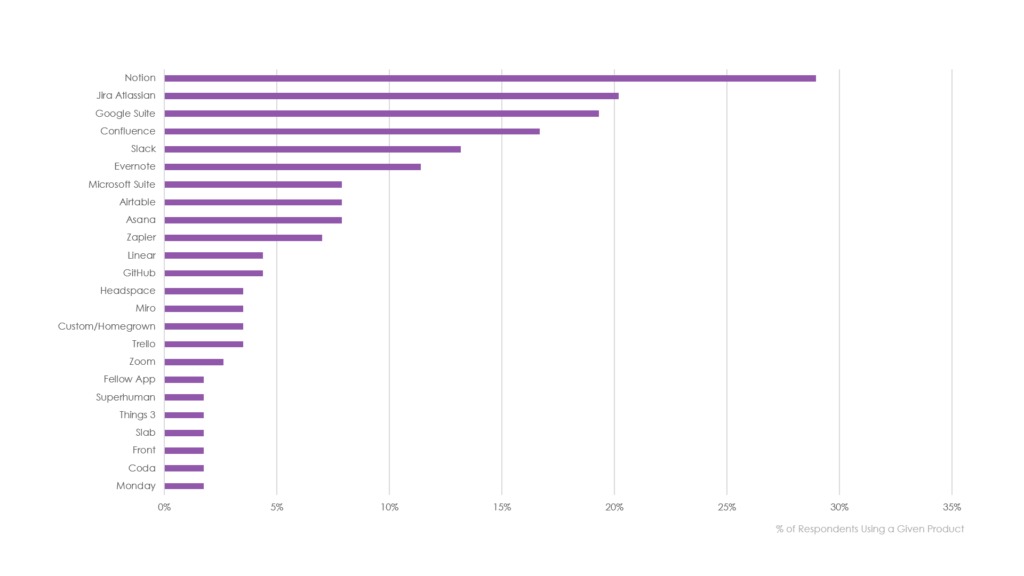
Great ideas come to all developers, but unless they can immediately contact the people they need and pull them into a meeting, asynchronous or web-based communication becomes increasingly important. These days most developer teams are at minimum hybrid, with many fully-remote, or even working in different parts of the world.
So, what are modern developers using to better collaborate with their teams? Jira came in at the top for us, with nearly a third of participants using it for project management and other forms of collaboration, with Miro, a fairly new whiteboarding tool often used for brainstorming, as a close second. Other popular contenders include several obvious names like Slack, Google Suite, Confluent, Asana, and Microsoft.
Figma (which Adobe has announced their intent to acquire), was a bit of a dark horse as well – another fairly young collaborative web application for interface design.
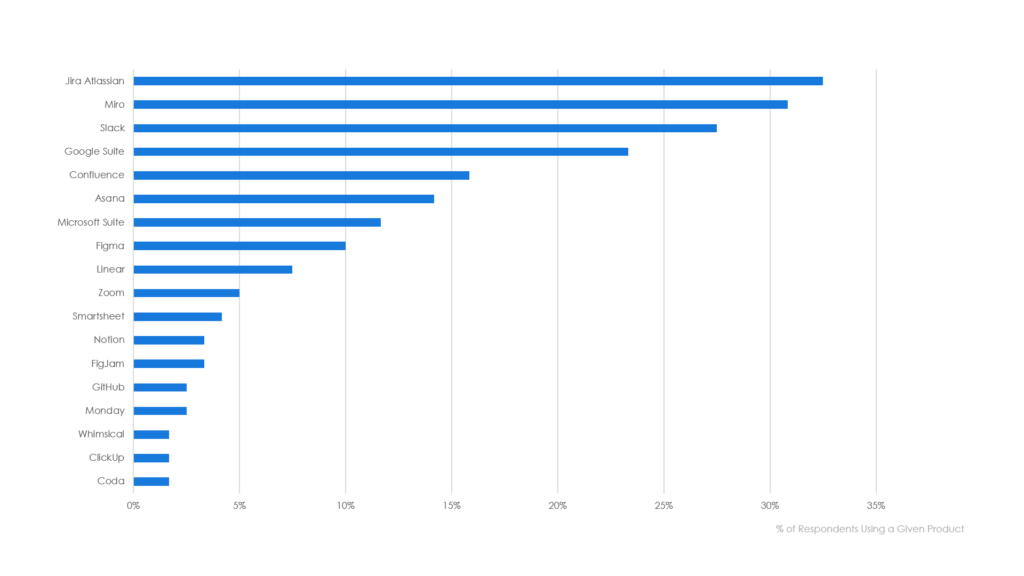
Product analytics is the process of analyzing how users engage with a product or service, by enabling product teams to track, visualize, and evaluate user engagement and behavioral data. Developers can then utilize this data to improve and optimize a product or service.
While this often falls under the purview of product management, development teams are increasingly involved here as they get closer and closer to the product and business side of the house. Some popular options here for our cohort included Amplitude, Mixpanel, Google Suite and Pendo, with over 10% reporting that they use a custom or homegrown solution and another 10% uninvolved in the product analytics process entirely.
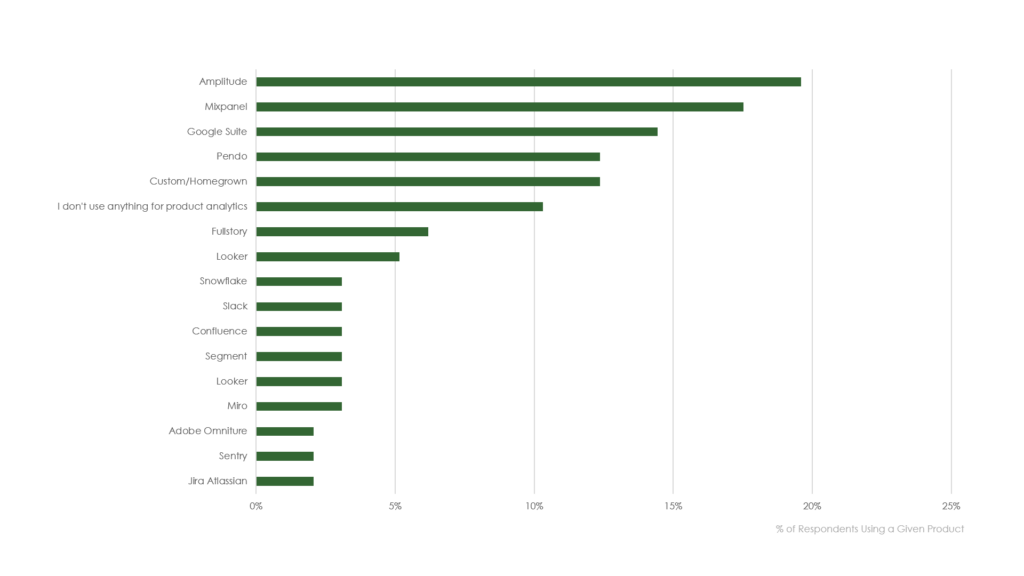
Good monitoring is a crucial factor when it comes to high-performing teams and achieving continuous delivery. Monitoring is tooling which enables teams to watch and understand the state of their systems. It’s based on gathering predefined sets of metrics or logs. Observability, on the other hand, is tooling that allows teams to actively debug. It’s based on exploring properties and patterns not defined in advance.
There’s a lot of complexity here and most solutions in the space require several moving parts: How is system health? How is the system being experienced by customers? How can systems be debugged in production? How can you identify unknown unknowns, including interactions between services?
The massive leader here for this cohort was Datadog, followed by New Relic, Sentry, and the ELK stack (Elasticsearch, Logstash, and Kibana).
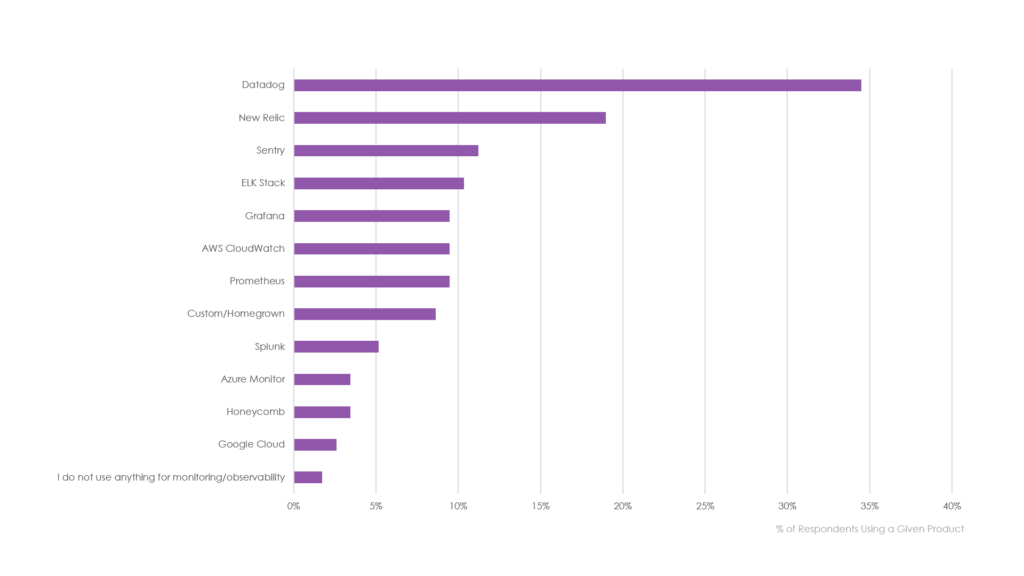
Incident response systems are necessary in order to quickly react to ongoing security breaches and deploy automated threat responses (threat hunting, anomaly detection, real-time responses via a playbook, incident analysis, etc.). Like monitoring and observability, most platforms use multiple tools to achieve their goals.
From a business standpoint, this is crucial, as having automated incident responses helps a company minimize the time and resources required to put out fires and scale small remediation teams more effectively. PagerDuty is the massive incumbent in the space, with a full two-thirds of respondents using it today, and a smaller cohort on OpsGenie.
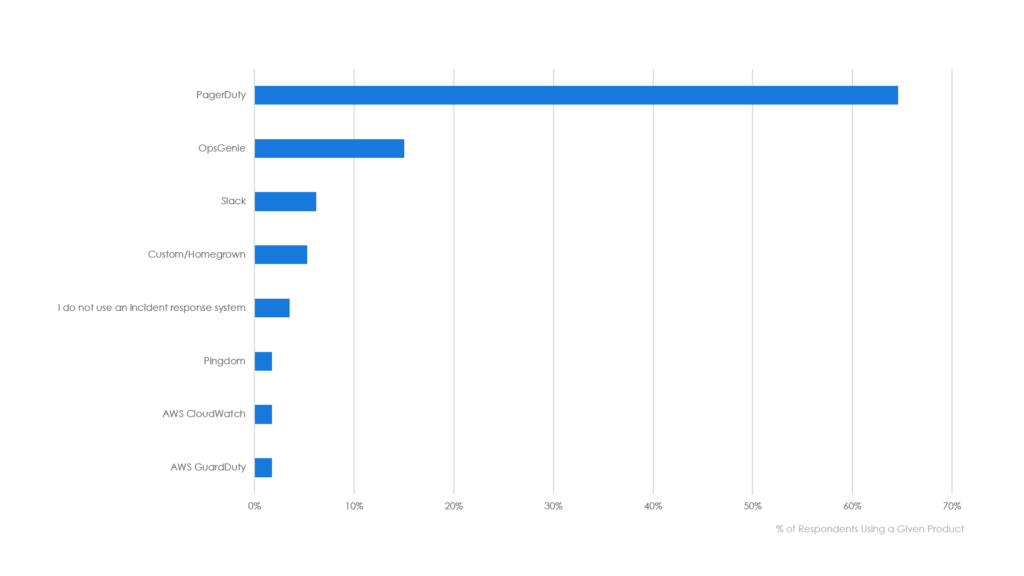
Historically, product support consisted of things like instructions in boxes or warranty programs, but over the years that has clearly shifted. Modern solutions typically involve digital helplines and chat for either technical or product-related inquiries, with the goal of ensuring that customers obtain the most value from use of the product after the sale. As time goes on, customers have increased their expectations here – anticipating faster support times, more convenient forms of contact, and just higher levels of support overall. In fact, better understanding customer expectations through modern customer support, and developing strategies for meeting them, is a major facet of product development and modern marketing.
Depending on the organization, developers may not be directly involved in this process, but about half of our participants reported using Zendesk, the clear leader from this survey on product feedback.

To some extent, this piece goes hand in hand with product support, but only covers the communication aspect. So, it makes sense that almost two-thirds of participants report using Slack here, and other conventional communication tools such as email, Zoom, Intercom, or, again, Zendesk.
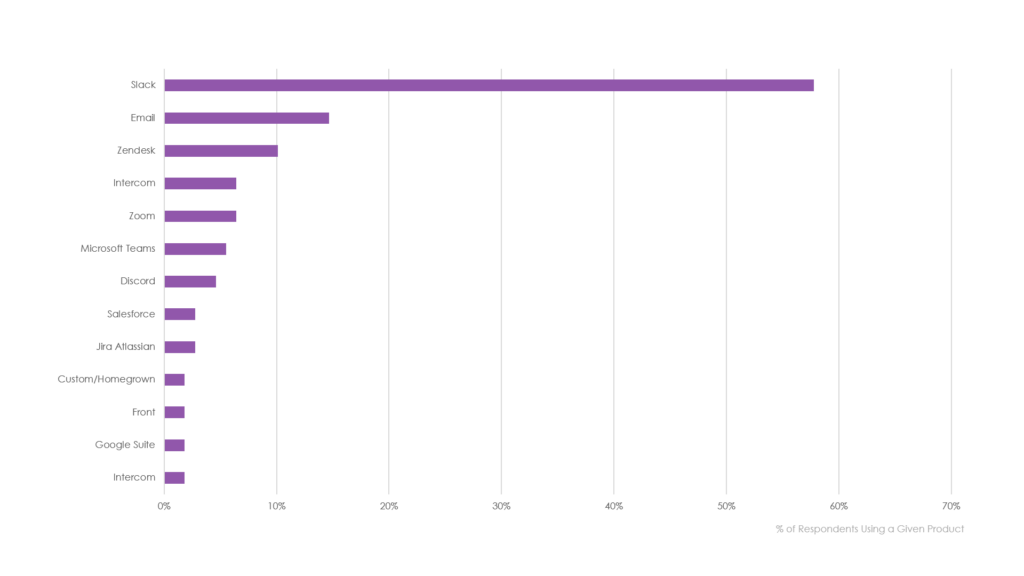
Customers having a positive experience is mandatory to the success of businesses small and large – happy customers increase their spending, remain loyal, and boost sales through positive reviews and word of mouth. The best marketing money can buy is customers who are advocates for your brand and product or service. This is a big reason why the “customer-obsessed” mentality started by Amazon has gained so much traction and popularity over the last decade.
That being said, a huge number of our participants– almost one-third – don’t currently use any tools here, a sign that outside of technical issues, development in many cases, is still very divorced from actually touching the customer themselves. For those that do engage, Hubspot was the clear leader, followed by Qualtrics.
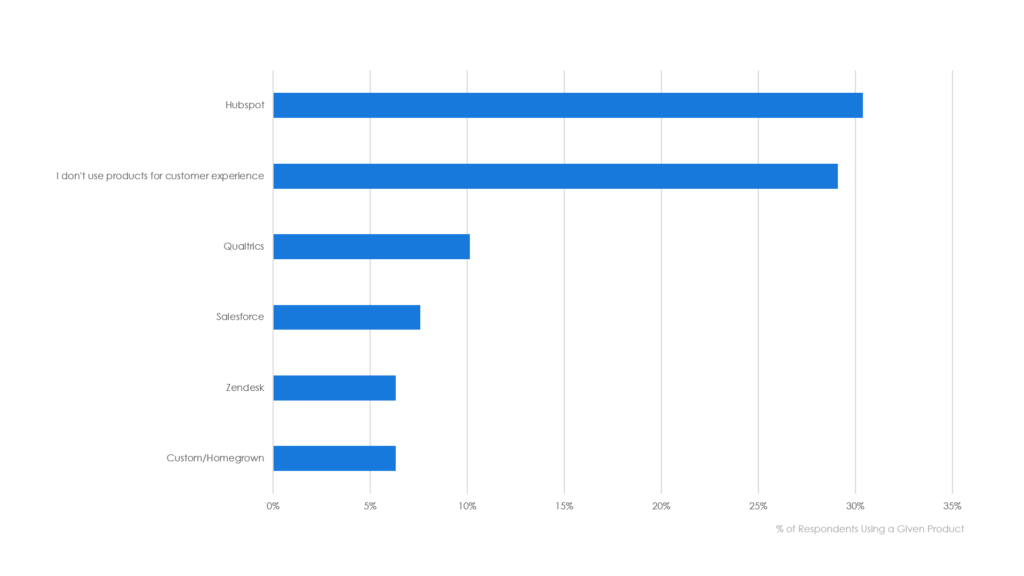

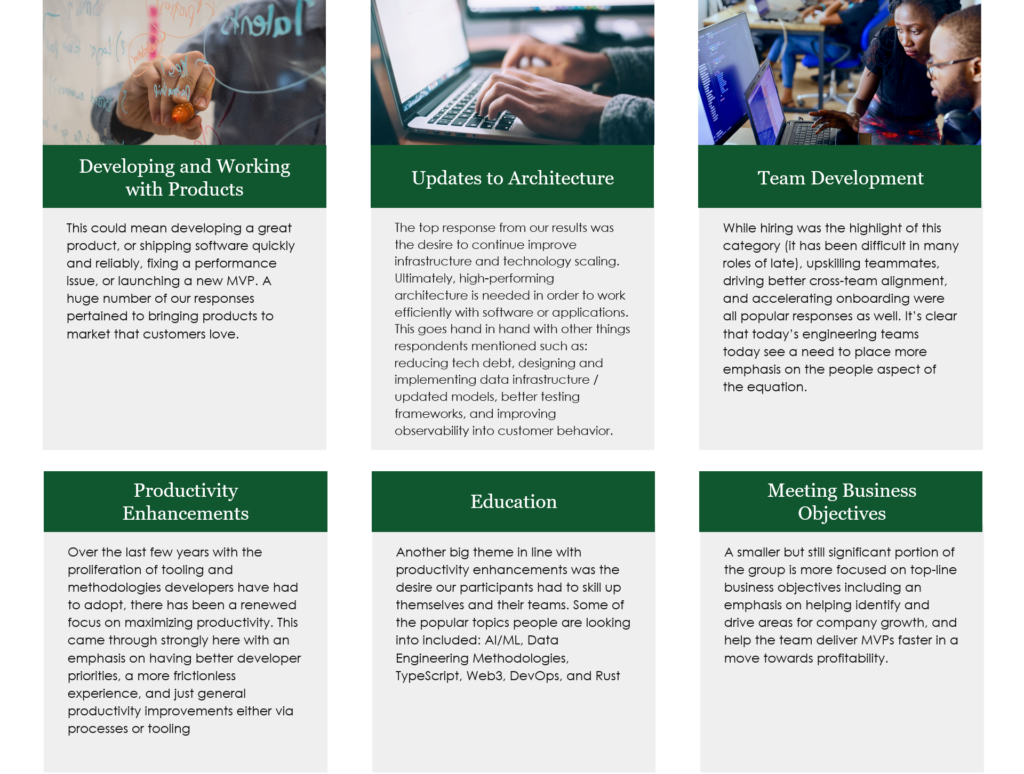
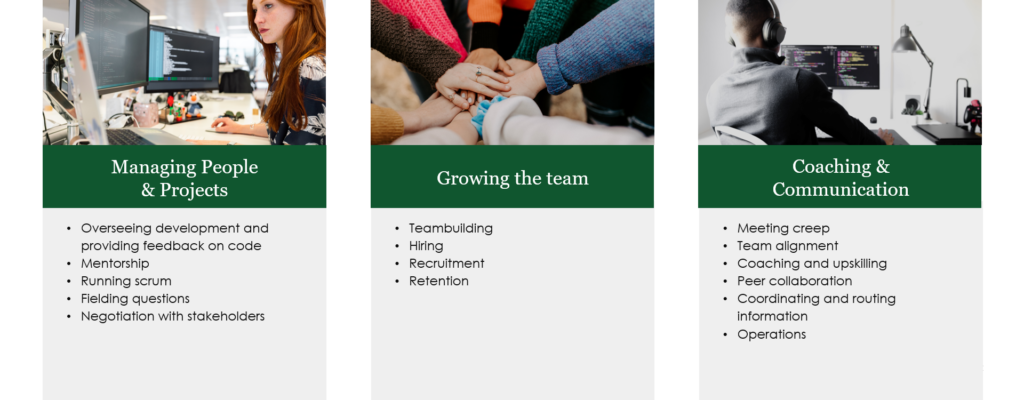

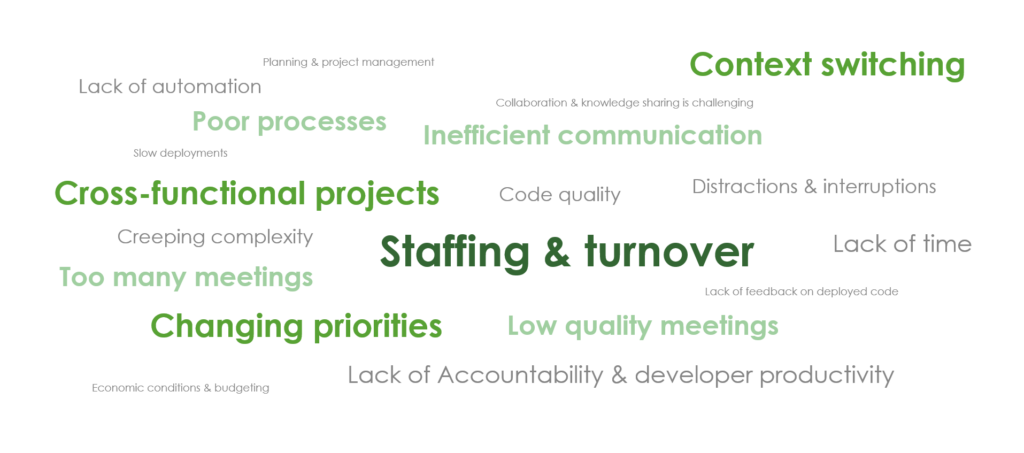
The top response to this question was that tools today are not the issue. Many engineering leaders are facing self-inflicted challenges around talent, culture, or process. Getting people on the same page can be difficult with remote and hybrid working models (or even without them). And often when it does come down to tools, one of the biggest difficulties is that implementation is just too long. That being said, a few standout gaps included project management tooling, better/faster observability, automated testing, and universal dependency management dashboards.

The two standouts on this question were Data and Service Mesh and Rust, but a surprisingly large number of respondents expressed a lack of interest in learning any new technologies. This could be because this survey was more focused on management, or due to general burnout around new tools and tech, especially following a long period of remote work. Other contenders included Web3, DevSecOps, ML Ops, TypeScript and Golang.

